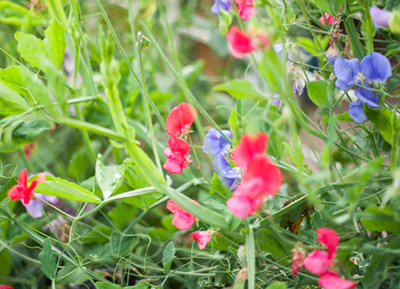Time to sow sweet peas
Plant your sweet peas now, and invest in the best seeds while you’re at it


If you want to buy any of the plants mentioned below for your own garden, visit www.countrylife.co.uk/nursery and type or copy and paste the name into the search. Plants are delivered in sturdy boxes in a matter of days from one of the finest nurseries in the country.
It's difficult to buy good-quality sweet peas as cut flowers, so we like to produce them for as long a season as possible. To do this, we make two sowings, one now and one in April. Our autumn-sown plants should be flowering by late May, continuing to bloom for about 12 weeks, at which point the spring-sown ones take over, flowering well into autumn.
Over the years, I've found that it's well worth investing in good-quality seed from a sweet-pea specialist, two of my favourites being Owl's Acre (01775 723284; www.sweetpea-seed.com) and Eagle Sweet Peas (01889 270215; www.eaglesweetpeas.co.uk). We grow a good range of colours and always go for strongly scented varieties, recommended for exhibition.
Sweet peas need a long root run and I've found that the cardboard tubes of finished loo rolls, packed together vertically, are perfect for sowing into. The cardboard is bio-degradable, so they can be planted together with the growing sweet pea, the roots growing through without disturbance. I fill each roll three-quarters full with seed compost, give them a good soaking and fill the remainder with dry compost.
Each seed is planted 1in deep and they're all covered with damp news-paper, to stop them drying out. Then, we keep them at about 15˚C in the glasshouse and avoid any watering until seed germination, when the newspaper is removed. Sweet peas can be erratic in germinating, but ‘chipping' can speed things up. This is done by carefully making a small nick in the seed coat, opposite the ‘eye', with a sharp knife, to help the seed absorb water.
Once we have good germination, we move the seedlings in their rolls to the cold frame, to be overwintered. Sweet peas are hardy down to -5˚C and opening up the cold frame lights on all but the coldest days ensures tough, stout plants. It's always important not to over-water during cold weather and if it gets very cold, we cover the frames with old carpet for extra insulation.

I no longer pinch out the growing tips to make the young plants bushy, as I find that too much premature side-shoot development can make them all unnecessarily tangled; instead, we grow ours as cordons, with just one terminal shoot. Cordoning sweet peas is the traditional method developed by exhibition growers to get the most out of the plants. The plant puts all of its energy into making fewer flowers, resulting in bigger blooms on longer stems. We start by planting out in the spring in well-manured soil, along an A-frame of tall canes, spaced at 1ft distances.
Sign up for the Country Life Newsletter
Exquisite houses, the beauty of Nature, and how to get the most from your life, straight to your inbox.
Each sweet pea is planted against its individual cane and the strongest stem is selected out and tied in. Then, it's trained in a similar way to a tomato, removing side shoots and curly tendrils, tying in the cordon as it grows. When the plants reach the top of the canes, they're taken down and ‘layered', by moving all the stems along by four canes, and tying them back in. This brings the flowers back down to picking height and gives the plants a fresh length of cane to grow up.
Last season, I wondered if it really is worth the effort, and grew a line of untrained sweet peas on hazel pea-sticks to compare. Initially, there wasn't much difference, but, by July, the contrast was clear. Although far less numerous, the cordon-grown blooms were much bigger, averaging four flowers on a 20in stem, whereas the majority of pea-stick-grown blooms only had two flowers, on short, crooked stems. As the season progressed, the difference became more extreme and the cordoned plants flowered for three weeks longer.
Although it's a lot of work training cordons, this is balanced out by the constant task of removing poor-quality blooms from the untrained plants. Plants tend to reward you for the work and care you put into them and, like most things in life, quality in sweet peas is far more satisfying than quantity.
Tom Coward is head gardener at Gravetye Manor, West Sussex (www.gravetyemanor.co.uk)
* Follow Country Life magazine on Twitter
* Give Country Life this Christmas and save up to 40%
Country Life is unlike any other magazine: the only glossy weekly on the newsstand and the only magazine that has been guest-edited by HRH The King not once, but twice. It is a celebration of modern rural life and all its diverse joys and pleasures — that was first published in Queen Victoria's Diamond Jubilee year. Our eclectic mixture of witty and informative content — from the most up-to-date property news and commentary and a coveted glimpse inside some of the UK's best houses and gardens, to gardening, the arts and interior design, written by experts in their field — still cannot be found in print or online, anywhere else.
-
 New balls please: Eddie Redmayne, Anna Wintour and Laura Bailey on the sensory pleasures of playing tennis
New balls please: Eddie Redmayne, Anna Wintour and Laura Bailey on the sensory pleasures of playing tennisLittle beats the popping sound and rubbery smell of a new tube of tennis balls — even if you're a leading Hollywood actor.
By Deborah Nicholls-Lee
-
 A rare opportunity to own a family home on Vanbrugh Terrace, one of London's finest streets
A rare opportunity to own a family home on Vanbrugh Terrace, one of London's finest streetsThis six-bedroom Victorian home sits right on the start line of the London Marathon, with easy access to Blackheath and Greenwich Park.
By James Fisher